Editor of this issue: Robertas Vitas
Copyright © 1997 LITUANUS Foundation, Inc.

|
LITUANUS
LITHUANIAN QUARTERLY JOURNAL OF ARTS AND SCIENCES
Volume 43, No. 4 - Winter 1997
Editor of this issue: Robertas Vitas ISSN 0024-5089
Copyright © 1997 LITUANUS Foundation, Inc. |

|
REFLECTIONS FROM A DISTANT MIRROR:
OSVALDAS BALAKAUSKAS1
REQUIEM IN MEMORIAM STASYS LOZORAITIS
Enrique Alberto Arias
DePaul University
The composition of a Requiem mass is always a special event in the life of a major composer, largely because of the distinguished and perhaps even overwhelming tradition of which the work will be a part. Osvaldas Balakauskas' Lozoraitis Requiem is for mezzo-soprano, mixed choir, and chamber orchestra consisting of flute, oboe, bass-clarinet, trombone, synthesizer, and strings. In a letter to me of 11 November 1996, Balakauskas wrote the following about his Requiem:
The work was composed in 1995. Five movements were per-formed at the festival of cantatas and oratorios Vratislavia Cantans (September 1995, Wroclaw, Poland). The whole work was performed in Vilnius and Kaunas in March 1996, then Klaipėda and Šiauliai. The performers were Judita Leitaitė (mezzo), the Aidija choir led by Romas Gražinis and the St. Christopher Chamber Orchestra conducted by Donatas Katkus.
Stasys Lozoraitis (1924-94) was a Lithuanian diplomat when it was occupied by the Red army and annexed to the Soviet Union in 1940. He remained in the diplomatic service in exile until Lithuania's independence was restored in 1990. During these years he was ambassador to the United States and the Vatican; thus Lozoraitis syrnbolized Lithuania's freedom during the 50 year Russian occupation. In 1993 he became a candidate for the Lithuanian presidency. Although he did not win, he will remain in Lithuanian memory as a champion of liberty and an example of honor and nobility.
The Requiem was composed keeping in mind the Medieval tradition of Christian music, from Gregorian chant, organum, to the motets of the Ars Nova. Although there are no direct quotations from this repertory, its melodic-harmonic principles are echoed in my composition. At times, these principles are altered in a modern manner, such as the polytonality of the "Confutatis," but the general atmosphere is marked by consonant serenity. The canonical text was used, but its order was somewhat modified.
Balakauskas' Requiem represents a major change in the composer's style. From the 1960s on, Balakauskas was deeply involved in a personal brand of atonality. Complex rhythms and textures abound in such a work as the Symphony No. l (1973) In addition, references to jazz and Lithuanian folk material confer a special energy and expressivity that have made Balakauskas one of Lithuania's leading composers. The Requiem, on the other hand, is tonal and seemingly quite simple, especially as compared with the work just cited. The composer himself once told me, "it (the Requiem) is even more old-fashioned than Palestrina." Although, as, we will see this is not completely true, the impact of the Requiem is immediate and profound, and the work came as a surprise to many listeners familiar with Balakauskas' previous compositions. In order to understand the reasons for this, I wish to put the work in a general as well as specific perspective.
The Requiem Tradition
The history of the Latin Requiem Mass is both long and complex. Suffice it to say that it had its origins in the English Salisbury usage of the Middle Ages, but that the order and selection of prayers were not standardized until the Council of Trent (1545-63) in the Missal of Pius V (1570). Polyphonic settings of the Requiem begin with Dufay's in the 15th century (now lost). The first extant setting is by Johannes Ockeghem from the later 15th century. During the 16th century, a number of major composers wrote Requiem Masses, including Pierre de la Rue and Tomas Luis de Victoria (the date of Victoria's Missa pro defunctis is 1583). Typical of these settings is a chordal simplicity, with the appropriate Gregorian chant presented in varied form in the superius, or top, voice. Usually short sections of chant alternate with the polyphonic sections, creating a series of textural contrasts. In general, Renaissance Requiem settings are austere and avoid the Dies Irae the text later most associated with the Requiem.
A number of composers wrote Requiem Masses during the 17th century, but it is only at the end of the 18th century that Requiems were written that made full use of the dramatic capabilities of the orchestra. The Grande Messe de morts (1760) by the French composer Frangois-Joseph Gossec has some striking orchestral effects that surely influenced Berlioz in the composition of his Requiem mentioned below. In addition, there are three beautiful Requiems by Michael Haydn (Joseph's brother), which combine the chorus and orchestra into a symphonic whole. The Requiem in C minor (1771) is said to have been an influence on the composition of the Mozart Requiem. It would now be customary for composers of Requiem Masses to make use of the same large orchestra found in the settings of the ordinary of the Mass by Haydn, Mozart, and Beethoven. The Requiem settings from the later 18th century on are thus a part of the symphonic mass tradition which blends the orchestra and voices into a large-scale design.
The major setting of the Requiem text from the later 18th century is of course Mozart's from 1791. This powerful work set the tone for the 19th-century Requiem by emphasizing the drama and contrast of the text. Its prestige, the enigmatic circumstances of its composition, and the question of its completion focused attention on the Requiem as a major form. Structurally and dramatically important is the high-lighting of the Dies Irae text - the description of the day of judgment.
Subsequent composers often looked to the Mozart Requiem as a reference. Luigi Cherubini, the important opera composer who worked in France during his later career, set the Requiem text twice: the first in c minor (1816), and the second in d minor (1836). Both have unusual features of scoring and texture - the first omits violin parts, while the second is for men's voices alone. But more importantly, Cherubini makes the setting of the Dies Irae text the center-piece of the work, a practice that would be followed by subsequent Romantic composers. The opportunity to compose a Requiem, furthermore, allowed the Romantic preoccupation with terror and violence full play.
Berlioz set the Requiem in his Grande Messe de morts (1837), with its stunning "Tuba mirum" portion of the Dies Irae for 4 brass bands, 16 timpani, and 10 cymbals. This vast and powerful work depicted death in all its awesome power. Similarly, Verdi wrote the Manzoni Requiem (1874), a tribute to an Italian national hero and author, using all the devices of dramatic opera. Here again the Dies Irae seizes the listener's attention with its insistent drum strokes and odd chromatic melodic contours.
On the other hand, Gabriel Fauré, wrote a more gentle and introspective Requiem (1887), even omitting the Dies Irae. Fauré was influenced by the Caecilian movement - a 19th-century emphasis on the Palestrina style and Gregorian tradition, as was Liszt in his Requiem (1867-68), written for a capella voices. Maurice Duruflé wrote a Requiem (1947), reflective of Fauré's setting and the Caecilian movement. These works contrast with the Romantic Requiem settings just de-scribed by their common view of death as tranquil rather than fearsome and their emphasis on such older styles as modality, unaccompanied chorus, and simpler textures.
It is to this retrospective outlook rather than the Romantic tradition of Requiem as a dramatization of death that the Balakauskas Requiem belongs.
Analysis of the Requiem and its Relationship to Medieval Practice
One of the most striking features of the Balakauskas' Requiem is its scoring. Notable is the mezzo-soprano solo. Rather than using a quartet of soloists - a practice found in many choral compositions - Balakauskas has allowed the soprano to be a commentator, as it were, on the text. One is reminded of the role of the tenor in Benjamin Britten's War Requiem (1961), although the two works could not be more different in style and general structure. An outline of the Balakauskas Requiem to be found later in the article will illustrate the structural and dramatic importance of the mezzo-soprano.
Also striking is the disposition of the chamber orchestra, with its inclusion of a synthesizer. Although a modern instrument, the synthesizer is employed to convey an organ-like sonority and to underpin the important harmonic and textural contrasts. The wind instruments create a diaphanous polyphony, resulting in an emphasis on linear textures and rhythmic complexity. The chamber orchestra sometimes forms blocks of sound which contrast with the chorus. An especially effective instance occurs at the opening of the Sanctus. Example 1.
In contrast to the disjunct style of many earlier pieces, most of the lines are more in conjunct motion, with frequent pentatonic cellsthis a reflection of Gregorian chant. Even though specific chants are not cited, according to the com-poser, many lines are Gregorian in style, as the opening mezzo-soprano solo from the "Tuba Mirum" illustrates. Here the repeated pitches and melodic patterns reflect Gregorian formulaic practice. Example 2.
Although the work is clearly not atonal, nor is it tonal in the traditional sense. Chords often move by thirds or whole steps instead of by fifths as in conventional tonality. The cadence at the end of the opening "Requiem" illustrates this and is especially surprising after the importance D was given at the outset. Example 3. The opening 10 measures of the Sanctus feature chords moving by thirds: A to F, G to E, and D to Bb. (See Example 1) This quick and complex harmonic movement is redolent of 14th-century polyphony.
Important harmonic structures in the Requiem result from the superimposition of fifths, as illustrated by the end of the "Domine Jesu." Note here how important the synthesizer is to the harmonic direction. Example 4.
The opening of the Agnus Dei has superimposed quartal harmonies similar to what is found in later Medieval polyphony. Example 5.
The synthesizer sometimes presents fifths in arpeggios to affirm the quintal harmonic structures. It is at such spots as this that the synthesizer's sonority confers an archaic quality. Example 6.
In the "Tuba mirum," the strings move in parallel harmonies, highlighting the quintal sonorities. (See Example 2) Parallel fifths in the style of Medieval organum are also found, as at the opening, where they establish the general atmosphere of the piece. (See Example 1)
Rhythmic layers are created by cross-rhythms, independent lines, and complex ornamentation. From the so-called Petronian motets (late 13th century) through the isorhythmic motets of Machaut and his contemporaries, the polyphony evolves from complex cross-rhythms or strata of rhythms. The following example from the "Lacrymosa" illustrate the similarity the Requiem has to this outlook. Example 7.
Complexity of texture results from the frequent independence of the voices. The Requiem's polyphony is often non-imitative, which is to say that the parts rarely have motivic relationships to each other - a common texture in late Medieval music. This is seen in many of the examples presented above.
Melodic phrases often intersect each other. At times Balakauskas comes close to the Medieval practice of hocket, where a melodic line is splintered among the voices. In the "Recordare" of the Dies Irae, this kind of hocket underlines the expressivity of the text. Three levels in the melodic inter-changes here occur: the voices, the winds, and the strings. Example 8.
The Requiem clearly makes melody the most important compositional factor. In this regard, the relationship to Medieval sacred monody has already been mentioned, but the melodic style is also redolent of Lithuanian folksongs, with their minor mode, conjunct style, and emphasis on repetition. An examination of the examples previously cited reveals a consistent emphasis on expressive melodic lines with motivic repetition and variation.
The choral styles cover a wide range of possibilities. Sometimes the voices move in unisons, emphasizing repeated tones in a manner similar to that of the Gregorian psalm tone formula. Example 9.
At times duet textures are emphasized. At the beginning of the "Rex tremendae" section of the Dies Irae, for example, the tenor voices move from seconds to parallel fifths, a practice redolent of 12th-century polyphony. Example 10.
At the opening of the "Recordare," on the other hand, one finds a texture that iš heard commonly throughout the Requiem. Here the two upper voices, doubled by the mezzo-soprano, are in close proximity, with fourths and fifths the prevalent intervals. These voice parts are in dialogue with the winds of the orchestra, which are treated in a choral fashion. The texture here is similar to that found in many 13th-century motets because of its high tessitura and close voice writing. (See Example 8)
Various relationships occur between the chorus and orchestra. At the opening the orchestra has a prolonged D, un-derpinning the voices - similar to what occurs in later 12th-century organa by Leoninus. Example 11.
At other times, as in a passage from the Sanctus, the orchestra has independent counterpoints. Notable here are the two levels in the texture: the choral voices in an organal-like style, while the strings and oboe create an intricate support. At the conclusion of the Dies Irae, on the other hand, the chorus and orchestra interact in an intricate hocket. The mysterious atmosphere of this section is highlighted by the extensive orchestral conclusion. Example 12.
Homophonic choral writing is used for text emphasis in the final Agnus Dei section. Here the quintal chordal progressions seem to "pull away" from normal tonal associations - an impression made by much 14th-century music. Part of the extraordinary expressivity of the Requiem's conclusion, with its modal cadence achieved by a descent of a third in the bass, results from the unusual root movements of the chords. The surprising shift from open fifths to full cadences underlines the idea of "eternal peace." Example 13.
The two upper voices sometimes answer the two lower, ("Rex tremendae" mm. lOOff.) as at the "Rex Tremendae," where the influence of Medieval organum is apparent. Example 14.
In the "Confutatis" the division of voices highlights the bitonality. Note again that many of the dissonant progressions resolve to perfect fifths - bitonality here symbolizing the confusion of the damned. Example 15.
The overall tonal organization of the work is intricate. The following few instances demonstrate the width of the harmonic spectrum. Although the opening has a sustained D, it cadences on C. The opening of the "Dies Irae" emphasizes Bb, but the final cadence has an Ab in the bass. Yet a Bb is heard at the top, thus creating a relationship to the opening. The "Rex Tremendae" begins with an Eb, yet ends with a cadence that slowly moves to F. Of interest here is the bitonal opposition between the F-C fifth and the Db-Ab fifth in the chorus, which slowly resolves to the C-G fifth at m. 131.
As we have seen, the final cadence of the work is on D and harkens back to the sustained D of the opening movement, thus creating an overall tonal unity. D is the finalis of the Dorian Medieval mode; thus it has symbolic import for the Requiem, where it stands for ancient authority and tradition. In general, the Requiem often suggests Medieval modality in its melodic-harmonic approach.
As the following outline illustrates, the mezzo-soprano is heard at intervals throughout, especially at more lyric moments. At times her voice is presented in dialogue with the chorus. But the mezzo-soprano is also used to double one of the female choral parts. Ornamental patterns in the spirit of Gregorian melismas confer expressivity to her part, so important in creating the tender atmosphere of the work as a whole.
The following is the general plan of the work, with indications about general stylistic features and where the mezzo-soprano part is important. It is meant to give the reader a sense of the work's macrostructure.
1. Requiem (This sets the general mood and style of the work as it stands. There are many repeated tones reminiscent of a Gregorian formula. Parallel fifths prevail, creating the atmosphere of Medieval organum. The D tonal center is emphasized at the outset. Chords created from stacked fifths prevail, while the orchestra provides rhythmic counterpoint to the choral texture).
2. Dies Irae (This is the longest section of the piece; hence it is its centerpiece. Each section of text is set separately. Nos 2 through 8 set this famous Medieval sequence. The opening section has hocket-Iike treatment).
3. Tuba mirum (The trombone is featured here with an ascending seventh to reflect the meaning of the text: "The trumpet giving forth wonderful sound." The mezzo-soprano has an important part in this section. Frequently the mezzo-soprano assumes the role of a commentator by emphasizing important words and phrases).
4. Rex tremendae (The general pacing slows down, with the chorus and orchestra moving at about the šame rate. The two upper and two lower voices answer each other. The oratorical rhythms emphasize the text which speaks of the "King's majesty")-
5. Recordare (This is one of the most impressive sections of the Requiem. The phrases are punctuated by rests, while the winds of the orchestra complement the chorus. The mezzo again has an important solo. This section ends with a strong cadence on B).
6. Confutatis (As has been mentioned previously, dissonance and bitonality prevail here. Thus there is tremendous contrast between the beginning of this and the ending of the previous movement. The work's harmonic friction reaches a climax in this section).
7. Domine Jesu (This begins with a long prelude in the orchestra. The chorus is treated in a declamatory manner, thus emphasizing each phrase of text. A Bb tonal center is affirmed here both at the beginning and at the end).
8. Hostias (This is the final section of the Dies Irae. It begins with long duet passages in the Alti-Bassi, then Mezzo-Soprano - Tenori. The mezzo again has an important role. Duets prevail, and syncopations are used to expressively highlight important syllables of text, especially the first. By this time these rhythmic patterns help create a sense of over-all unity).
9. Sanctus (A reduction to three parts occurs at the outset. The mezzo again has an important solo, sometimes doubling the sopranos of the chorus. The strings present expressive and supportive counterpoint to the rest of the texture, resulting in cross-rhythms. The movement reaches a climax in the "Osanna," which, unlike the general custom, is not treated separately).
10. Benedictus (This is the traditional continuation of the Sanctus text The Bassi and later the Alti sing solo lines reflective of the Gregorian style. Again the orchestra weaves independent counterpoint).
11. Lacrymosa (This is one of the most expressive portions of the Requiem. The synthesizer has an important solo emphasizing overlapping fifths. The mezzo also has an impressive solo, while the texture becomes more complex as the movement progresses. An F# cadence appears at the end).
12. Agnus Dei (This is the finai movement of the Requiem. It begins with a prelude for flute, bass-clarinet, trombone, and synthesizer, followed by the rest of the orchestra. The texture becomes more spacious at the text "dona eis requiem aeternam." At m. 138 the mezzo appears for the final solo. The chorus and mezzo exchange phrases in the last part of the movement. Repeated tones and chords again provide a formulaic quality) .
Although there are 12 sections or movements, there are only 5 texts, with, as is usual, the Dies Irae and Sanctus subdivided. The mezzo is heard in the more introspective and expressive sections, where the darkness of the voice provides contrast. The synthesizer supports the harmonic progressions, but also confers an organ-like sonority, thus contributing to the generally Medieval atmosphere. As mentioned above, D is the tonal center of the beginning and conclusion, and the formulaic aspect of the beginning is also echoed at the end. Subtle contrasts of texture, pacing, and orchestration evolve the work's macrostructure, though the general impression is one of homogeneity and tranquility.
In conclusion, Balakauskas is one of a number of twentieth century composers fascinated by the compositional procedures of the Middle Ages. Hindemith, Messiaen, and more recently John Taverner and Arvo Prät have experimented with quartal-quintal harmonies, hocket, and isorhythm. The Balakauskas Requiem is thus part of a twentieth century "neo-medieval" tradition. Its rich expressivity draws on the old to create the new.
Example 1
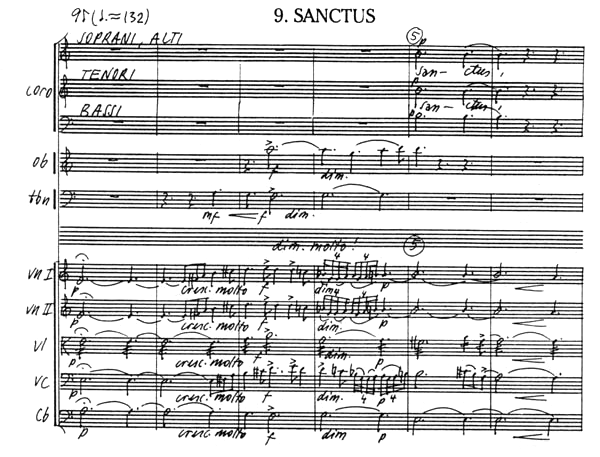
Example 2
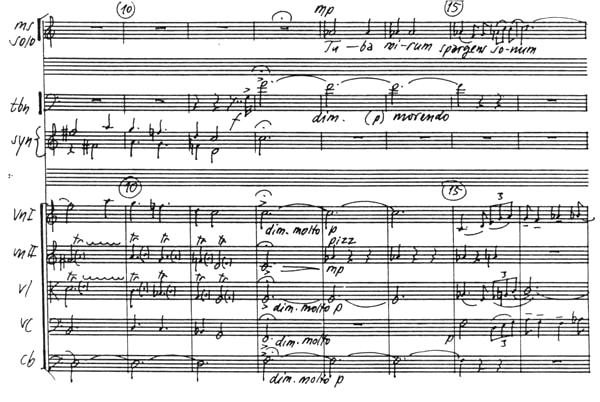
Example 3
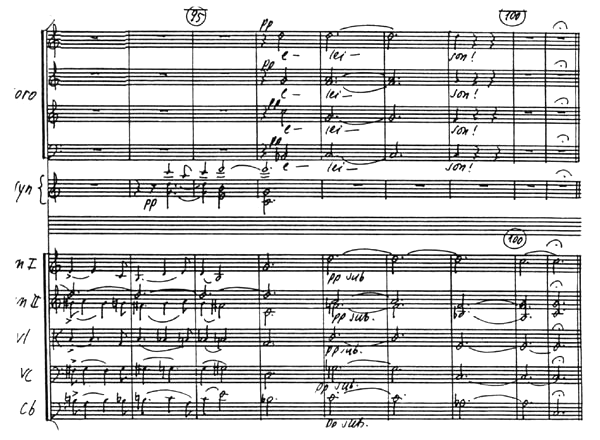
Example 4
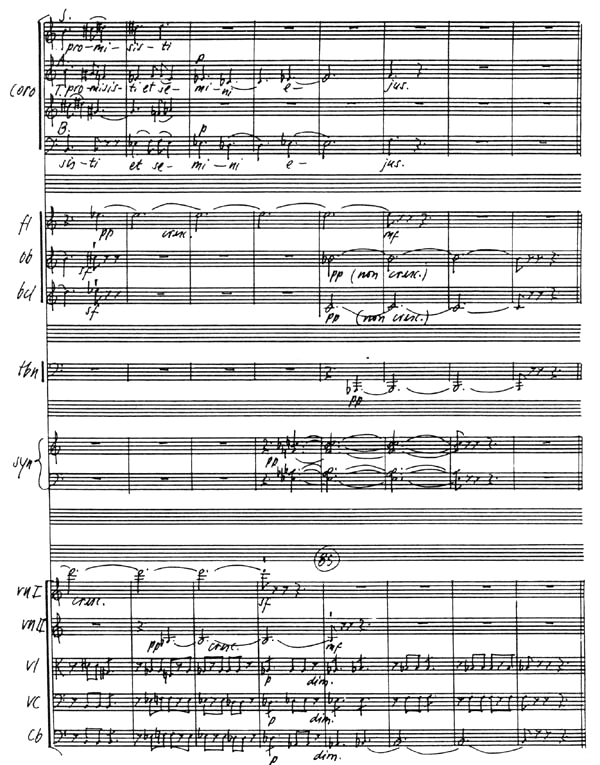
Example 5
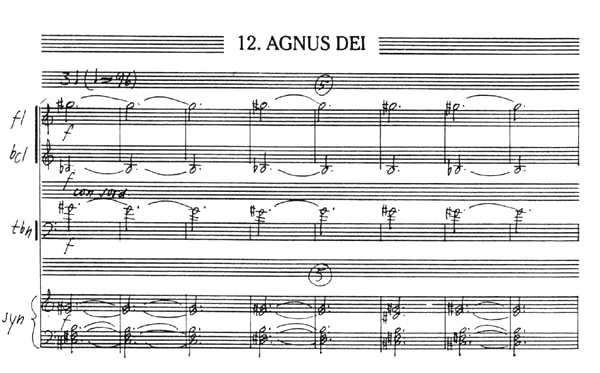
Example 6
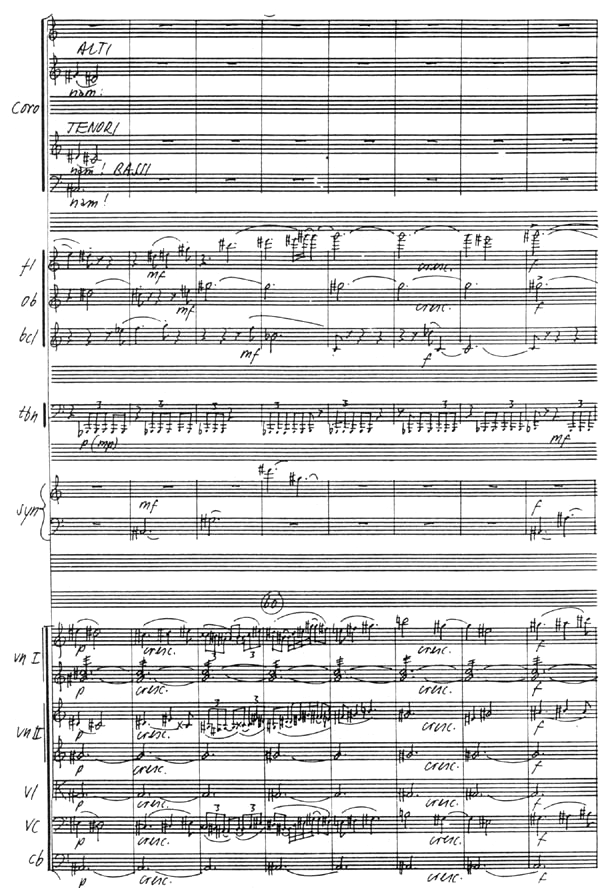
Example 7
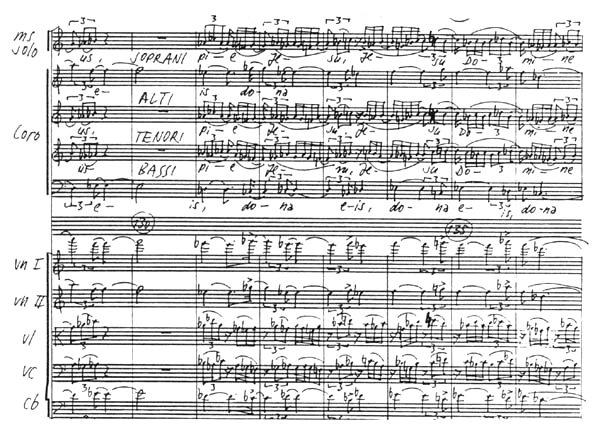
Example 8
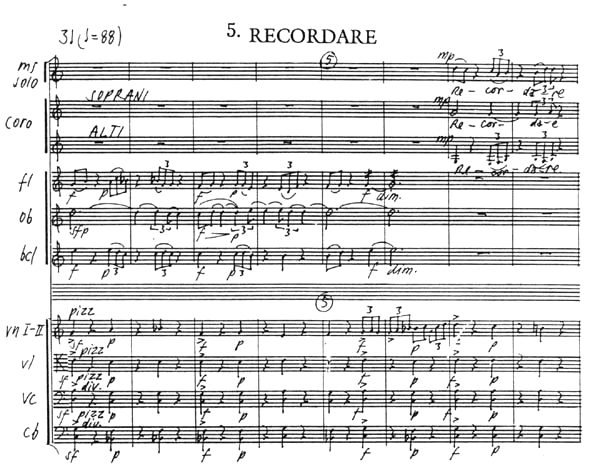
Example 9
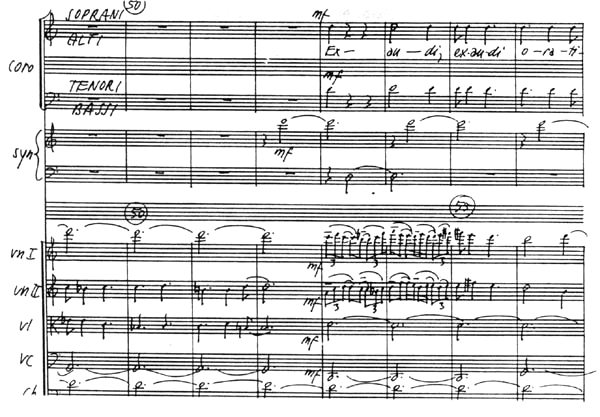
Example 10
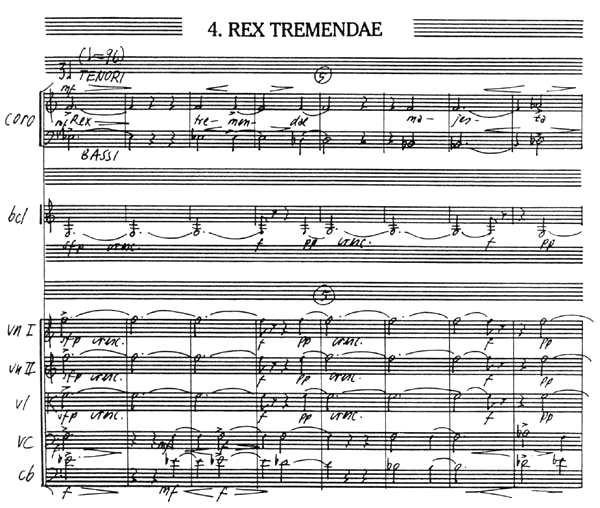
Example 11
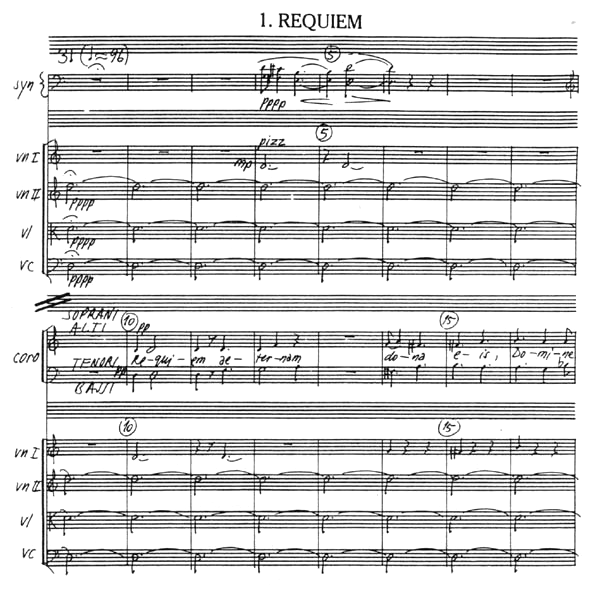
Example12
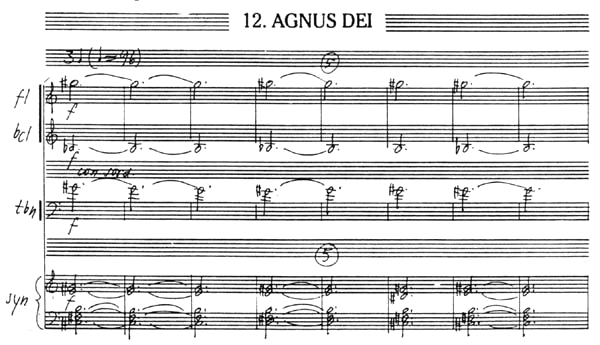
Example13
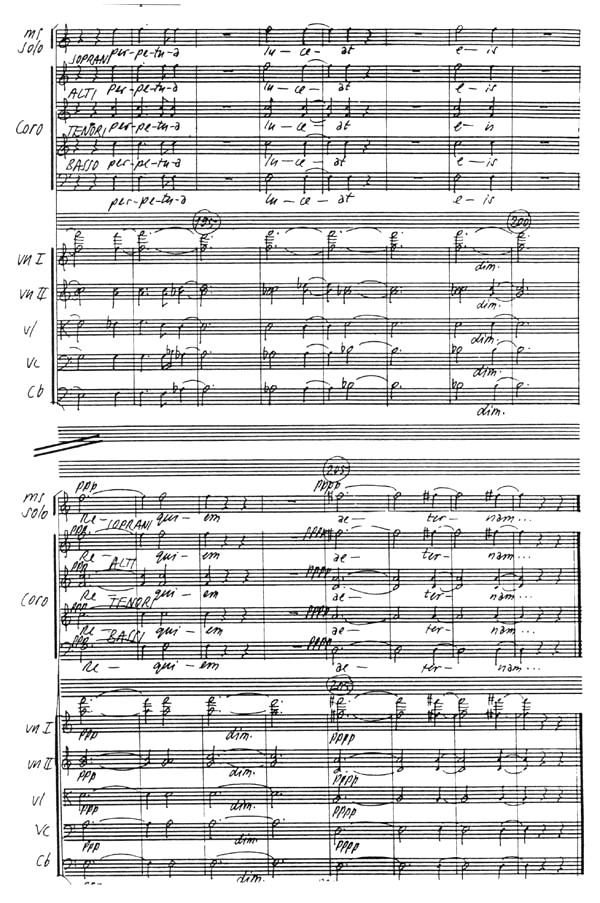
Example 14
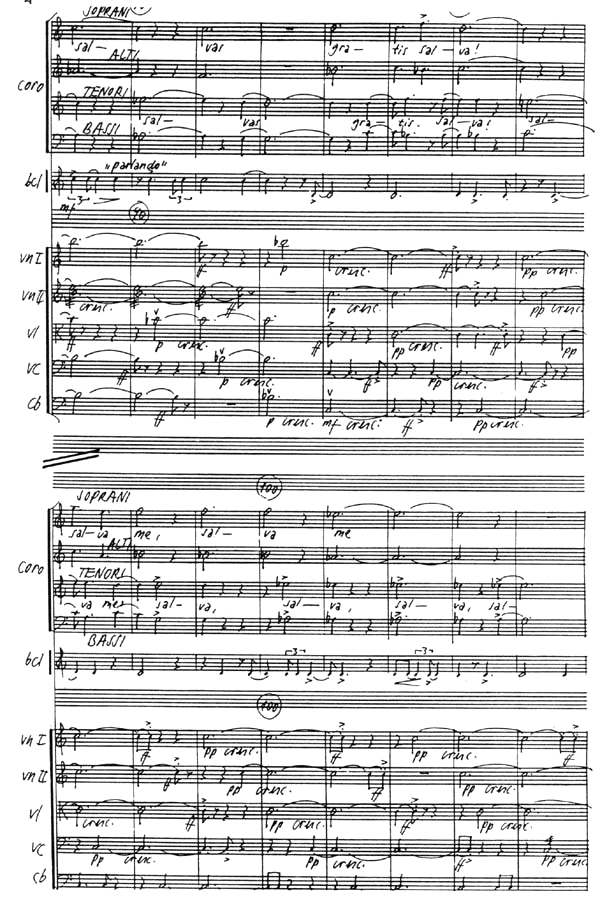
Example 15
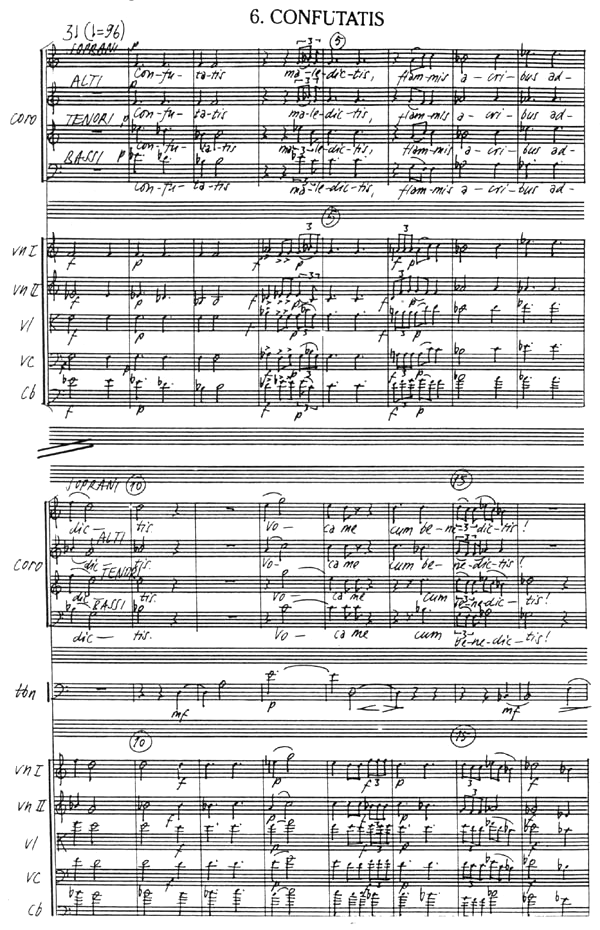
1-Enrique Alberto Arias earned his Ph.D. in Musicology from Northwestern University. He is currently Assistant Professor at the School for New Learning, De Paul University. The present article results from two visits he made in 1993 and 1996 to the GAIDA festival of contemporary music in Vilnius. During these visits he met and became a friend of Oslvadas Balakauskas, one of Lithuania's most distinguished composers.